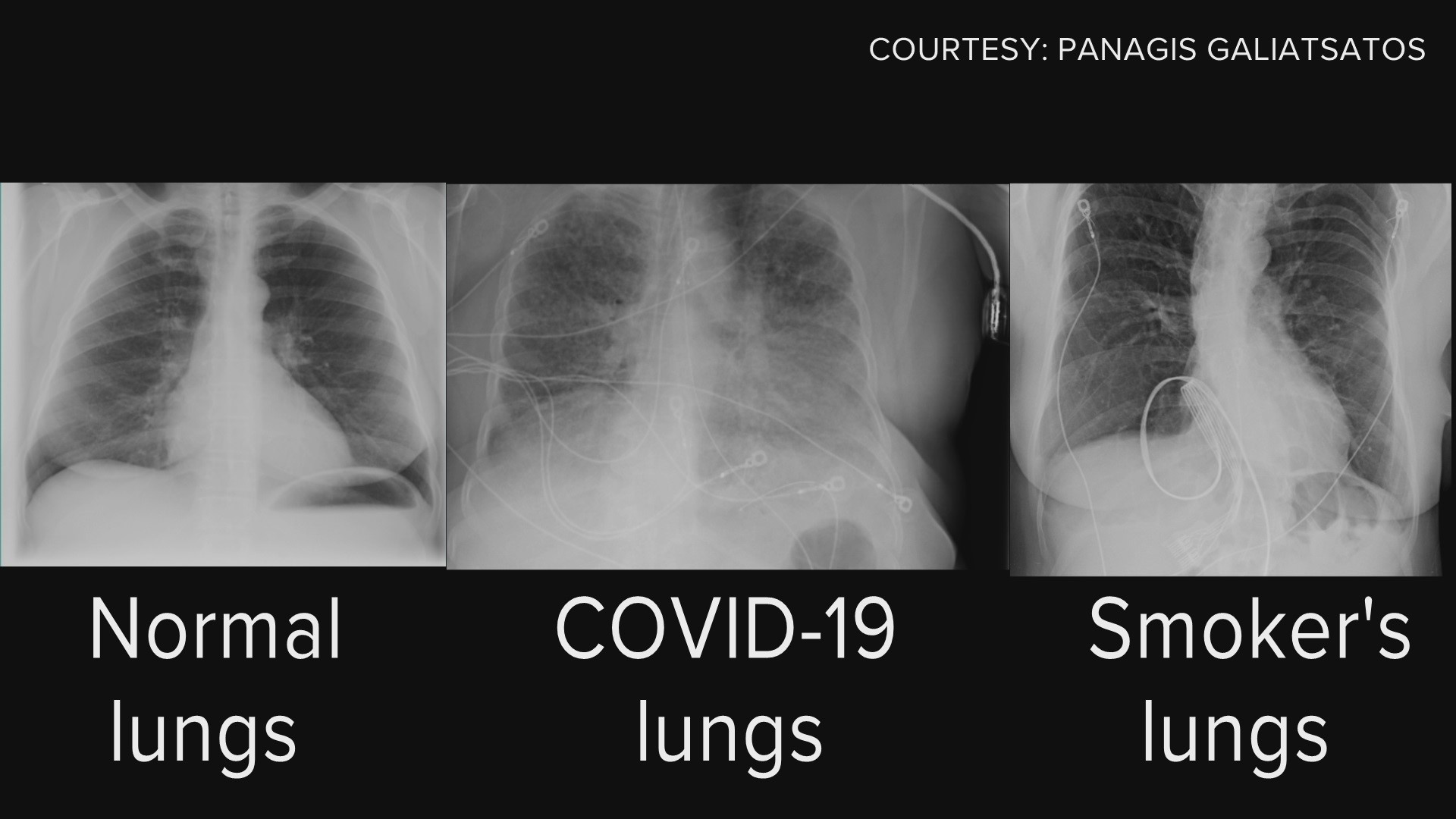
Logistic Regression
MSSC 6250 Statistical Machine Learning
Department of Mathematical and Statistical Sciences
Marquette University
Binary Logistic Regression
Non-Gaussian and Non-continuous Response
-
In many applications, the response or error term are nonnormal.
- Binary response: how an online banking system determine whether or not a transaction is fraudulent based on the user’s IP address.
- Count response: how weather conditions affect the number of users of a bike sharing program during a particular hour of the day.
Besides normal, the response in a generalized linear model (GLM) can be Bernoulli, binomial, Poisson, etc.
There is no assumption that \(\mathrm{Var}(y_i)\) is homogeneous: Both \(E(y_i)\) and \(\mathrm{Var}(y_i)\) may vary with the regressors from data point to data point.
Ordinary least squares does not apply when the response is not normal.
Classification
- Linear regression assumes that the response \(Y\) is numerical.
- In many situations, \(Y\) is categorical.
- A process of predicting categorical response is known as classification.
Normal vs. COVID vs. Smoking
fake news vs. true news

Regression Function \(f(x)\) vs. Classifier \(C(x)\)


Soft and Hard Classifiers
Two popular approaches when modeling binary data
-
Soft classifiers
- Estimate the conditional probabilities \(Pr(Y = k \mid {\bf X})\) for each category \(k\).
- Use \(\mathbf{1}\{Pr(Y \mid {\bf X}) > c \}\) for classification, where \(c \in(0, 1)\) is a threshold or cutoff.
- e.g. logistic regression
-
Hard classifiers
- Directly estimate the classification decision boundary
- e.g. support vector machines
Classification Example
Given the training data \(\{(x_i, y_i)\}_{i=1}^n\), we build a classifier to predict whether people will default on their credit card payment \((Y)\) yes or no, based on monthly credit card balance \((X)\).


Why Not Linear Regression
\[Y =\begin{cases} 0 & \quad \text{if not default}\\ 1 & \quad \text{if default} \end{cases}\]
- \(Y = \beta_0 + \beta_1X + \epsilon\), \(\, X =\) credit card balance
What are potential issues with this dummy variable approach?
- \(\hat{Y} = b_0 + b_1X\) estimates \(P(Y = 1 \mid X) = P(default = yes \mid balance)\).
- However,
Why Not Linear Regression?
- Probability estimates can be outside \([0, 1]\).
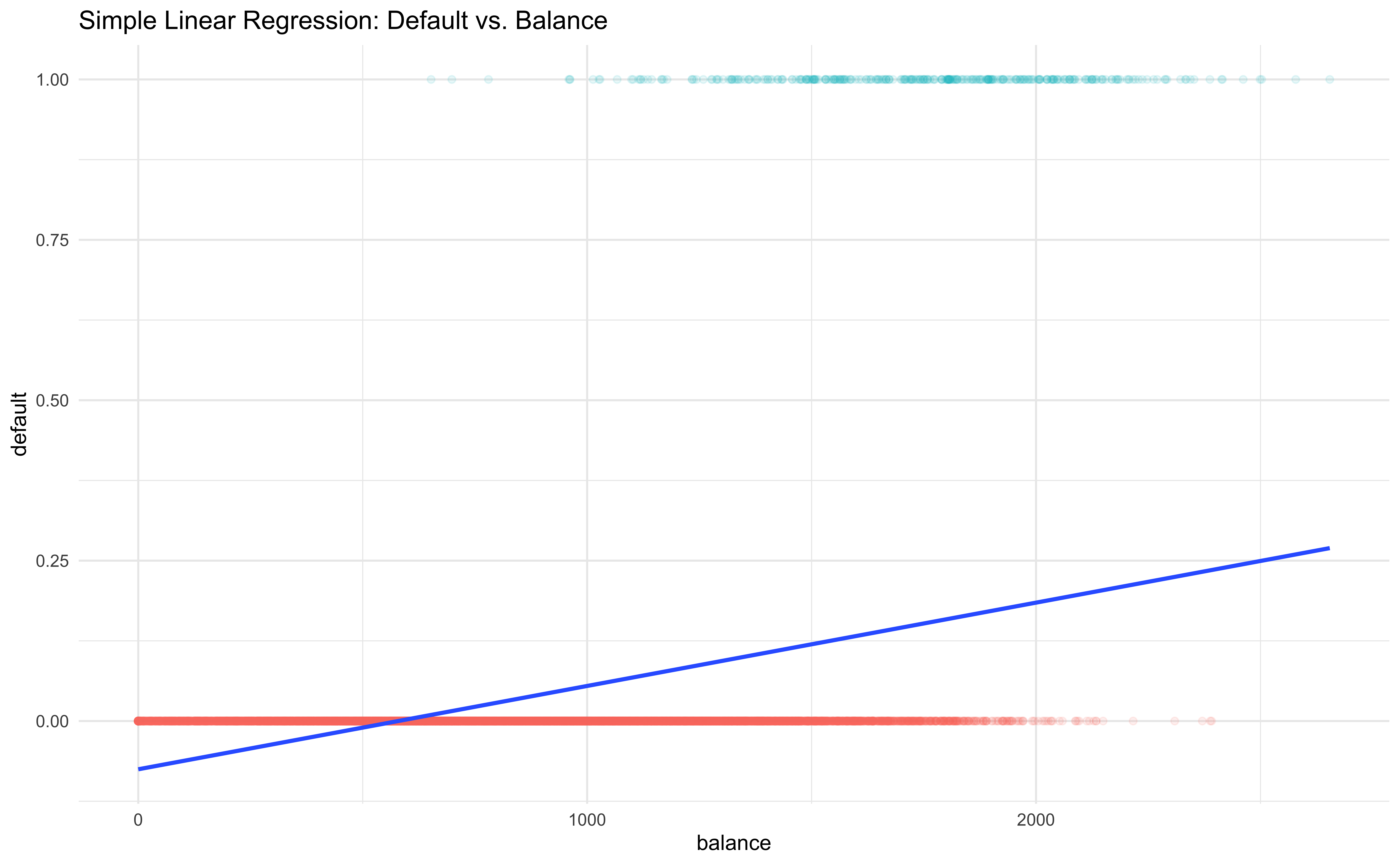
Why Not Linear Regression?
- Linear regression generally cannot handle more than two categories.
\[Y =\begin{cases} 1 & \quad \text{stroke}\\ 2 & \quad \text{drug overdose} \\ 3 & \quad \text{epileptic seisure} \end{cases}\]
-
The coding
- suggests an ordering
epileptic seisure\(>\)drug overdose\(>\)stroke - implies that
stroke\(-\)drug overdose\(=\)drug overdose\(-\)epileptic seizure.
- suggests an ordering
Binary Logistic Regression
- First predict the probability of each category of \(Y\)
- Predict probability of
defaultusing a S-shaped curve.
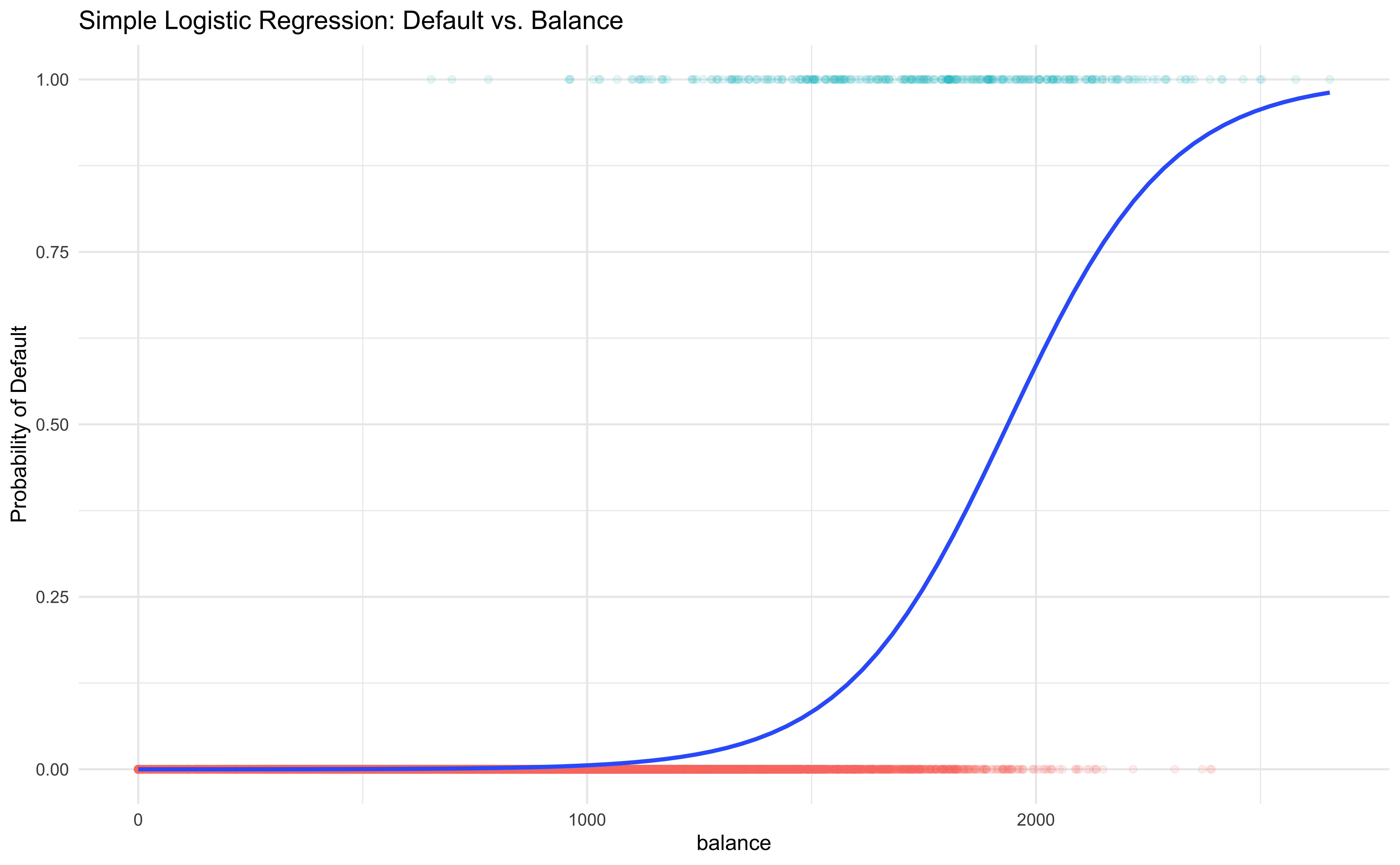
Framing the Problem: Binary Responses
We use normal distribution for numerical \(y\). What distribution we can use for binary \(y\) that takes value 0 or 1?
- Each outcome
default\((y = 1)\) andnot default\((y = 0)\) is a Bernoulli variable. But,
- The probability of “success” \(\pi\) is not constant but varies with predictor values!
\[ y_i \mid x_i \stackrel{indep}{\sim} \text{Bernoulli}(\pi_i = \pi(x_i)) = \text{binomial}(m=1,\pi = \pi_i) \]
-
\(X =\)
balance. \(x_1 = 2000\) has a larger \(\pi_1 = \pi(2000)\) than \(\pi_2 = \pi(500)\) with \(x_2 = 500\) - Credit cards with a higher balance are more likely to be defaulted.

Logistic Function
Instead of predicting \(y_i\) directly, we use the predictors to model its probability of success, \(\pi_i\).
But how?
- Transform \(\pi \in (0, 1)\) into a variable \(\eta \in (-\infty, \infty)\). Then construct a linear predictor on \(\eta\): \(\eta_i = \mathbf{x}_i'\boldsymbol \beta\)
- Logit function: For \(0 < \pi < 1\)
\[\eta = \text{logit}(\pi) = \ln\left(\frac{\pi}{1-\pi}\right)\]
Logit function \(\eta = \text{logit}(\pi) = \ln\left(\frac{\pi}{1-\pi}\right)\)

Logistic Function
- The logit function \(\eta = \text{logit}(\pi) = \ln\left(\frac{\pi}{1-\pi}\right)\) takes a value \(\pi \in (0, 1)\) and maps it to a value \(\eta \in (-\infty, \infty)\).
- Logistic function: \[\pi = \text{logistic}(\eta) = \frac{1}{1+\exp(-\eta)} \in (0, 1)\]
- The logistic (sigmoid) function takes a value \(\eta \in (-\infty, \infty)\) and maps it to a value \(\pi \in (0, 1)\).
- Once \(\eta\) is estimated by the linear regression, we use the logistic function to transform \(\eta\) back to the probability.
Logistic (Sigmoid) Function \(\pi = \text{logistic}(\eta) = \frac{1}{1+\exp(-\eta)}\)

Logistic Regression Model
For \(i = 1, \dots, n\) and with \(p\) predictors: \[Y_i \mid \pi_i({\bf x}_i) \stackrel{indep}{\sim} \text{Bernoulli}(\pi_i), \quad {\bf x}_i' = (x_{i1}, \dots, x_{ip})\] \[\text{logit}(\pi_i) = \ln \left( \frac{\pi_i}{1 - \pi_i} \right) = \eta_i = \beta_0+\beta_1 x_{i1} + \cdots + \beta_p x_{ip} = {\bf x}_i'\boldsymbol \beta\]
- The \(\eta_i = \text{logit}(\pi_i)\) is a link function that links the linear predictor and the mean of \(Y_i\).
\[\small E(Y_i) = \pi_i = \frac{1}{1 + \exp(-{\bf x}_i'\boldsymbol \beta)}\] \[\small \hat{\pi}_i = \frac{1}{1 + \exp(-{\bf x}_i'\hat{\boldsymbol \beta} )}\]
Default Data in ISLR2
default student balance income
1 No No 730 44362
2 No Yes 817 12106
3 No No 1074 31767
4 No No 529 35704
5 No No 786 38463
6 No Yes 920 7492
7 No No 826 24905
8 No Yes 809 17600
9 No No 1161 37469
10 No No 0 29275str(Default)'data.frame': 10000 obs. of 4 variables:
$ default: Factor w/ 2 levels "No","Yes": 1 1 1 1 1 1 1 1 1 1 ...
$ student: Factor w/ 2 levels "No","Yes": 1 2 1 1 1 2 1 2 1 1 ...
$ balance: num 730 817 1074 529 786 ...
$ income : num 44362 12106 31767 35704 38463 ...Fitting 1
Estimate Std. Error z value Pr(>|z|)
(Intercept) -10.6513 0.36116 -29 3.6e-191
balance 0.0055 0.00022 25 2.0e-137\(\hat{\eta} = \text{logit}(\hat{\pi}) = \ln \left( \frac{\hat{\pi}}{1 - \hat{\pi}}\right) = -10.65 + 0.0055 \times \text{balance}\)
Interpretation of Coefficients
The ratio \(\frac{\pi}{1-\pi} \in (0, \infty)\) is called the odds of some event.
- Example: If 1 in 5 people will default, the odds is 1/4 since \(\pi = 0.2\) implies an odds of \(0.2/(1−0.2) = 1/4\).
\[\ln \left( \frac{\pi(x)}{1 - \pi(x)} \right)= \beta_0 + \beta_1x\]
- Increasing \(x\) by one unit
- changes the log-odds by \(\beta_1\)
- multiplies the odds by \(e^{\beta_1}\)
- \(\beta_1\) does not correspond to the change in \(\pi(x)\) associated with a one-unit increase in \(x\).
- \(\beta_1\) is the change in log odds associated with one-unit increase in \(x\).
Interpretation of Coefficients
Estimate Std. Error z value Pr(>|z|)
(Intercept) -10.651 0.36 -29 0
balance 0.005 0.00 25 0- \(\hat{\eta} = \text{logit}(\hat{\pi}) = \ln \left( \frac{\hat{\pi}}{1 - \hat{\pi}}\right) = -10.65 + 0.0055 \times \text{balance}\)
- \(\hat{\eta}(x) = \hat{\beta}_0 + \hat{\beta}_1x\)
- \(\hat{\eta}(x+1) = \hat{\beta}_0 + \hat{\beta}_1(x+1)\)
- \(\hat{\eta}(x+1) - \hat{\eta}(x) = \hat{\beta}_1 = \ln(\text{odds}_{x+1}) - \ln(\text{odds}_{x})\)
- One-unit increase in
balanceincreases the log odds ofdefaultby 0.005 units.
- The odds ratio, \(\widehat{OR} = \frac{\text{odds}_{x+1}}{\text{odds}_{x}} = e^{\hat{\beta}_1} = e^{0.0055} = 1.005515\).
- The odds of
defaultincreases by 0.5% with additional one unit of credit cardbalance.
Pr(default) When Balance is 2000
\[\log\left(\frac{\hat{\pi}}{1-\hat{\pi}}\right) = -10.65+0.0055\times 2000\]
\[ \hat{\pi} = \frac{1}{1+\exp(-(-10.65+0.0055 \times 2000)} = 0.586\]
pi_hat <- predict(logit_fit, type = "response")
eta_hat <- predict(logit_fit, type = "link") ## default gives us b0 + b1*x
predict(logit_fit, newdata = data.frame(balance = 2000), type = "response") 1
0.59 Probability Curve
What is the probability of default when the balance is 500? What about balance 2500?
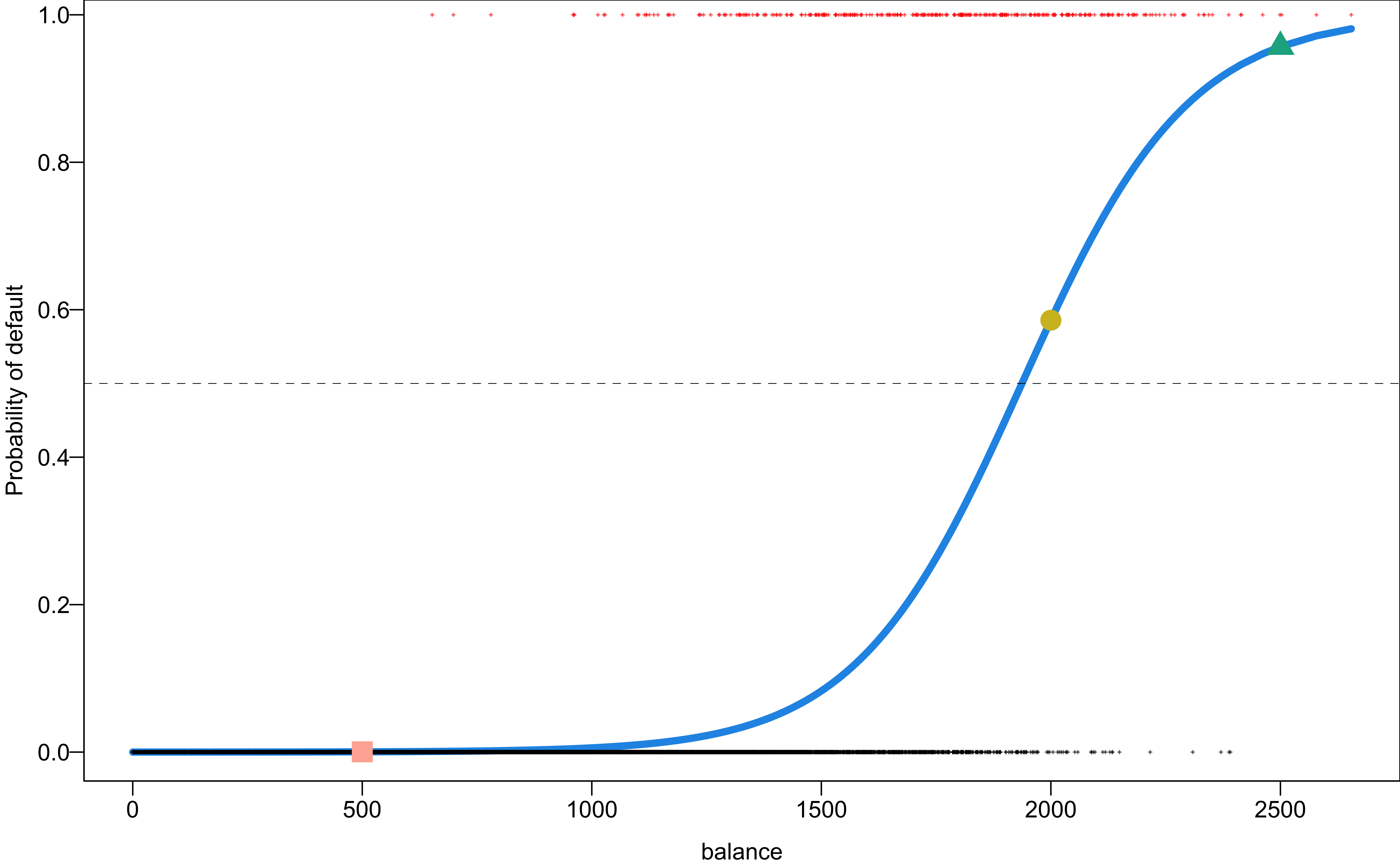
- 500 balance: Pr(default) = 0
- 2000 balance: Pr(default) = 0.59
- 2500 balance: Pr(default) = 0.96
Maximum Likelihood Estimation
-
glm()uses maximum likelihood to estimate the parameters \(\boldsymbol \beta\).
The log-likelihood is given by
\[\ell(\boldsymbol \beta) = \sum_{i=1}^n \log \, p(y_i \mid x_i, \boldsymbol \beta).\]
Using Bernoulli probabilities, we have
\[\begin{align} \ell(\boldsymbol \beta) =& \sum_{i=1}^n \log \left\{ \pi(\mathbf{x}_i)^{y_i} [1-\pi(\mathbf{x}_i)]^{1-y_i} \right\}\\ =& \sum_{i=1}^n y_i \log \frac{\pi(\mathbf{x}_i)}{1-\pi(\mathbf{x}_i)} + \log [1-\pi(\mathbf{x}_i)] \\ =& \sum_{i=1}^n y_i \mathbf{x}_i' \boldsymbol \beta- \log [ 1 + \exp(\mathbf{x}_i' \boldsymbol \beta)] \end{align}\]
Maximum Likelihood Estimation
- We can use Newton’s method that needs the gradient and Hessian matrix.
\[\boldsymbol \beta^{\text{new}} = \boldsymbol \beta^{\text{old}} - \left[ \frac{\partial ^2 \ell(\boldsymbol \beta)}{\partial \boldsymbol \beta\partial \boldsymbol \beta'}\right] ^{-1}\frac{\partial \ell(\boldsymbol \beta)}{\partial \boldsymbol \beta}\]
- Simply use
optim()
x <- as.matrix(cbind("intercept" = 1, Default$balance))
y <- as.matrix(as.numeric(Default$default) - 1)
beta <- rep(0, ncol(x)) ## start with 0
optim(beta, fn = my_loglik, gr = my_gradient, method = "BFGS",
x = x, y = y,
control = list("fnscale" = -1))$par # "fnscale" = -1 for maximization[1] -10.6454 0.0055Evaluation1
- Confusion Matrix
| True 0 | True 1 | |
|---|---|---|
| Predict 0 | True Negative (TN) | False Negative (FN) |
| Predict 1 | False Positive (FP) | True Positive (TP) |
Sensitivity (True Positive Rate) \(= P( \text{predict 1} \mid \text{true 1}) = \frac{TP}{TP+FN}\)
Specificity (True Negative Rate) \(= P( \text{predict 0} \mid \text{true 0}) = \frac{TN}{FP+TN}\)
Accuracy \(= \frac{TP + TN}{TP+FN+FP+TN} = \frac{1}{m}\sum_{j=1}^mI(y_j = \hat{y}_j)\), where \(y_j\)s are true test labels and \(\hat{y}_j\)s are their corresponding predicted label.
A good classifier can be the one which the test accuracy rate is highest, or test error rate \(\frac{1}{m}\sum_{j=1}^mI(y_j \ne \hat{y}_j)\) is smallest.
Confusion Matrix 1
Receiver Operating Characteristic (ROC) Curve
- The ROC curve plots True Positive Rate (Sensitivity) vs. False Positive Rate (1 - Specificity)
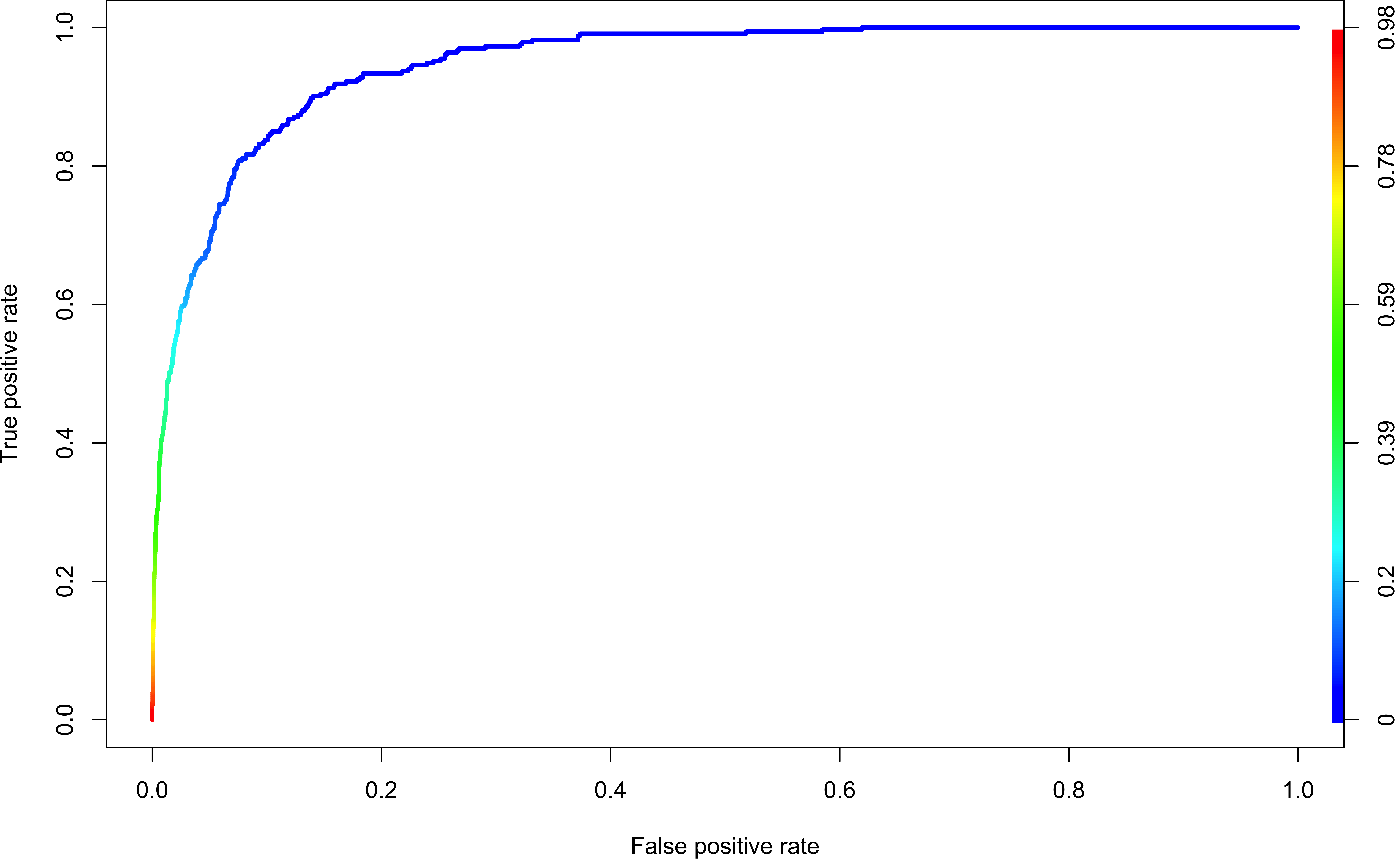
library(ROCR)
# create an object of class prediction
pred <- ROCR::prediction(
predictions = pred_prob,
labels = Default$default)
# calculates the ROC curve
roc <- ROCR::performance(
prediction.obj = pred,
measure = "tpr",
x.measure = "fpr")
plot(roc, colorize = TRUE, lwd = 3)Area Under Curve (AUC)
Find the area under the curve:
## object of class 'performance'
auc <- ROCR::performance(
prediction.obj = pred,
measure = "auc")
auc@y.values[[1]]
[1] 0.95
Threshold 0.5 Issue
- Threshold 0.5 may be inappropriate if
- imbalanced data or skewed class distribution in training
- the cost of one type of misclassification is more important than another.
Optimal Threshold
From the training set, choose the cut-off that maximizes
G-Mean \(= \sqrt{\text{TPR} * \text{TNR}}\) (geometric mean of TPR and TNR)
Youden’s J index \(= \text{TPR} + \text{TNR} - 1\) (the distance to the 45 degree identity line)
or that minimizes
- D-optimal Threshold \(= \sqrt{(1 - \text{TPR})^2 + (1 - \text{TNR})^2}\) (the distance to the optimal point)
Optimal Threshold
With Youden’s J index, the optimal threshold is \(3.18\%\).

Multinomial Logistic Regression
Multinomial Logistic Regression
When classifying \(K > 2\) categories, we can consider multinomial logistic regression1.
The response should be nominal. If \(Y_i\) is ordinal, we should consider the ordinal regression.


Multinomial Link
- First select a single class to serve as the baseline, the \(K\)th class for example.1
For \(k = 1, 2, \dots, K-1,\)
\[Pr(Y = k \mid {\bf x}) = \dfrac{e^{\beta_{k0}+\beta_{k1}x_1 + \cdots + \beta_{kp}x_p}}{ \sum_{l=1}^{K}e^{\beta_{l0}+\beta_{l1}x_1 + \cdots + \beta_{lp}x_p}},\] and \[Pr(Y = K \mid {\bf x}) = \dfrac{1}{ \sum_{l=1}^{K}e^{\beta_{l0}+\beta_{l1}x_1 + \cdots + \beta_{lp}x_p}}.\]
For \(k = 1, \dots, K-1\), \[\log\left( \frac{Pr(Y = k \mid \mathbf{x})}{Pr(Y = K \mid \mathbf{x})} \right) = \beta_{k0}+\beta_{k1}x_1 + \cdots + \beta_{kp}x_p.\]
Multinomial Link
First select a single class to serve as the baseline, the \(K\)th class for example.1
\(\pi_{ik} = Pr(Y_i = k \mid {\bf x}_i)\): the probability that the \(i\)-th response falls in the \(k\)-th category.
\(\sum_{k = 1}^K \pi_{ik} = 1\) for each observation \(i\).
- For \(k = 1, \dots, K-1\), the link \(\eta_{ik} = \log\left( \frac{\pi_{ik}}{\pi_{iK}}\right) = \beta_{k0}+\beta_{k1}x_1 + \cdots + \beta_{kp}x_p = {\bf x}_i'\boldsymbol \beta_k\), where \(\boldsymbol \beta_k = (\beta_{k0}, \beta_{k1}, \dots, \beta_{kp})'\)
What is the value of \(\eta_{iK}\)?
For \(k = 1, \dots, K\),
\[\pi_{ik} = \dfrac{e^{\eta_{ik}}}{\sum_{l=1}^{K}e^{\eta_{il}}}; \left(\pi_{iK} = \dfrac{1}{\sum_{l=1}^{K}e^{\eta_{il}}} \right)\]
Multinomial Data
Rows: 200
Columns: 3
$ prog <fct> vocation, general, vocation, vocation, vocation, general, vocati…
$ ses <fct> low, middle, high, low, middle, high, middle, middle, middle, mi…
$ write <dbl> 35, 33, 39, 37, 31, 36, 36, 31, 41, 37, 44, 33, 31, 44, 35, 44, …- Response:
-
prog(program type:general,academic,vocation)
-
- Predictors:
-
ses(social economic status:low,middle,high) -
write(writing score)
-
Multinomial Logit - Variable Association
Program type is affected by social economic status
prog
ses general academic vocation
low 16 19 12
middle 20 44 31
high 9 42 7and writing score
M SD
general 51 9.4
academic 56 7.9
vocation 47 9.3The level (coding order) of prog is
[1] "general" "academic" "vocation"Multinomial Logit - Setting Baseline
[1] "academic" "general" "vocation"-
academic= 1 (baseline),general= 2,vocation= 3 - For
ses,low= 1 (baseline),middle= 2,high= 3
\[\log \left( \frac{Pr(prog = general)}{Pr(prog = academic)}\right) = b_{10} + b_{11}I(ses = 2) + b_{12}I(ses = 3) + b_{13}write\]
\[\log \left( \frac{Pr(prog = vocation)}{Pr(prog = academic)}\right) = b_{20} + b_{21}I(ses = 2) + b_{22}I(ses = 3) + b_{23}write\]
All others held constant,
\(b_{13}\): the amount changed in the log odds of being in
generalvs.academicprogram aswriteincreases one unit.\(b_{21}\) the amount changed in the log odds of being in
vocationvs.academicprogram if moving fromses = "low"toses = "middle".
Multinomial Logit - nnet::multinom()
multino_fit <- nnet::multinom(prog2 ~ ses + write, data = multino_data, trace = FALSE)
summ <- summary(multino_fit)
summ$coefficients (Intercept) sesmiddle seshigh write
general 2.9 -0.53 -1.16 -0.058
vocation 5.2 0.29 -0.98 -0.114glmnet()uses the softmax coding that treats all \(K\) classes symmetrically, and coefficients have a different meaning. (ISL eq. (4.13), (4.14))The fitted values, predictions, log odds between any pair of classes, and other key model outputs remain the same.
glmnet(x = input_matrix, y = categorical_vector, family = "multinom",
family = "multinomial", lambda = 0)Multinomial Logit - Estimated Probability
academic general vocation
1 0.15 0.34 0.51
2 0.12 0.18 0.70
3 0.42 0.24 0.34
4 0.17 0.35 0.48
5 0.10 0.17 0.73
6 0.35 0.24 0.41- Hold
writeat its mean and examine the predicted probabilities for each level ofses.
dses <- data.frame(ses = c("low", "middle", "high"),
write = mean(multino_data$write))
predict(multino_fit, newdata = dses, type = "probs") academic general vocation
1 0.44 0.36 0.20
2 0.48 0.23 0.29
3 0.70 0.18 0.12Multinomial Logit - Probability Curve
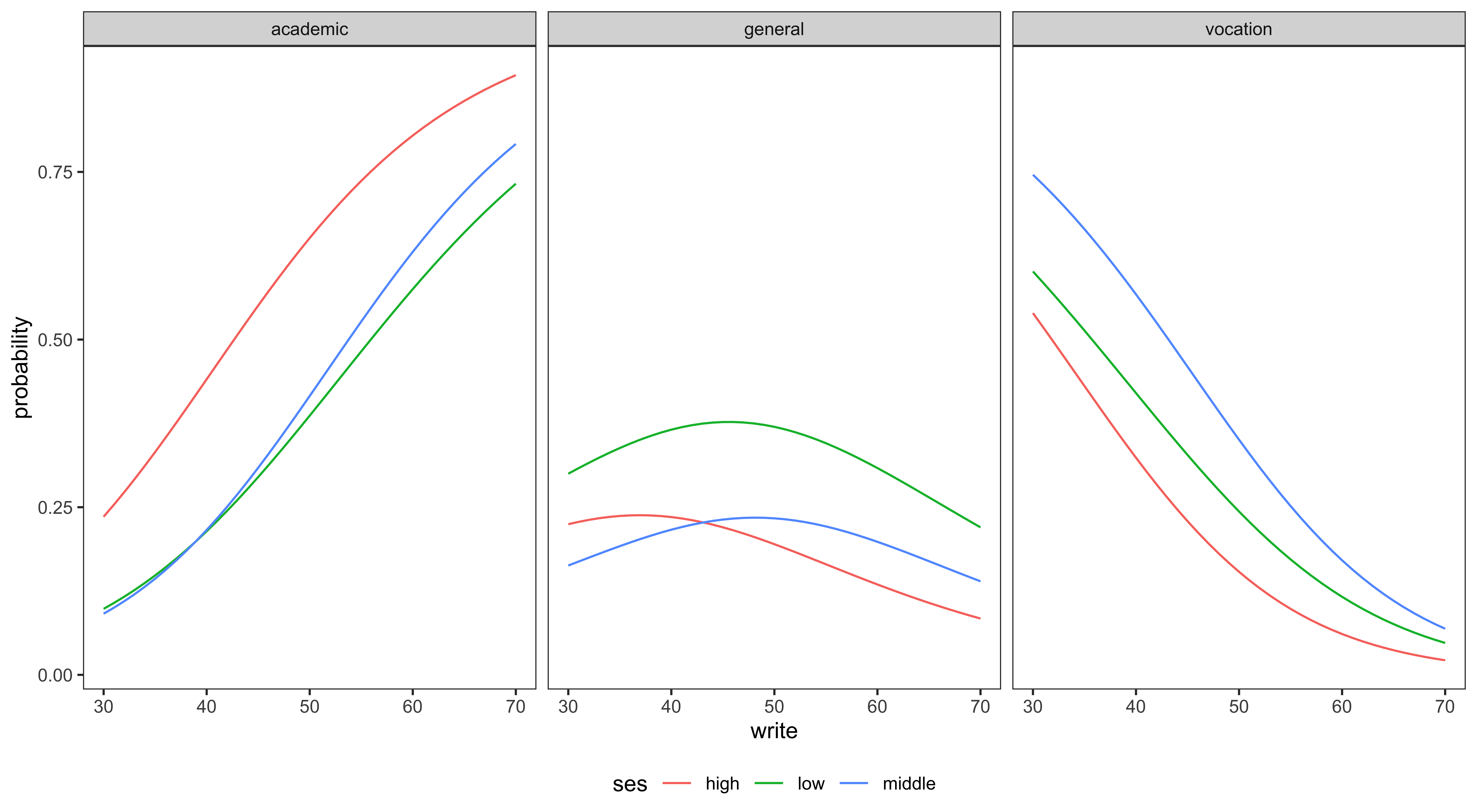
Generalized Linear Models
Generalized Linear Models in Greater Generality
-
Conditional on \(\mathbf{X}\), the response \(Y\) belongs to a certain family of distribution.1
- Linear regression: Gaussian
- Logistic regression: Bernoulli, binomial, multinomial
-
Model the mean of \(Y\) as a function of the predictors.
- Linear regression: \(E(Y \mid \mathbf{x}) = \mathbf{x}'\boldsymbol \beta\)
- Logistic regression: \(E(Y \mid \mathbf{x}) = P(Y=1 \mid \mathbf{x}) = \pi(\mathbf{x}) = \frac{e^{\mathbf{x}'\boldsymbol \beta}}{1 + e^{\mathbf{x}'\boldsymbol \beta}}\)
- In general, with \(E(Y \mid \mathbf{x}) = \mu\), the link function \(\eta(\mu) = {\bf x}'\boldsymbol \beta\) transforms \(\mu\) so that the transformed mean is a linear function of predictors!
- Linear regression: \(\eta(\mu) = \mu\)
- Logistic regression: \(\eta(\mu) = \log(\mu/(1-\mu))\)
Link Function
Logistic regression uses the logit function \(\eta = g(\pi) = \ln\left( \dfrac{\pi}{1-\pi}\right)\) as the link function.
\(\pi = \dfrac{1}{1 + e^{-\eta}} \in (0, 1)\) is the CDF of the logistic distribution, whose PDF is of the from \[f(\eta) = \frac{e^{-\eta}}{(1 + e^{-\eta})^2}, \quad \eta \in(-\infty, \infty)\]
Could use a different link function and hence CDF to describe the probability curve.
Probit and Complementary log-log (cloglog) Link
- If \(\pi = \Phi(\eta) \in (0, 1)\), \(\Phi(\cdot)\) is the CDF of standard normal distribution, the link function \[\eta = g(\pi) = \Phi^{-1}(\pi)\] is called probit, and the model is called probit model or probit regression.
- Another popular link function is the complementary log-log link: \[\eta = g(\pi) = \log\left( -\log(1-\pi)\right)\] where \(\pi = 1 - \exp(-\exp(\eta))\) is the CDF of the so called Gumbel distribution.1
Link Function Summary
| Distribution | Link Function \(\eta = g(\pi)\) | CDF \(\pi = g^{-1}(\eta)\) | |
|---|---|---|---|
| Logistic | logit: \(\ln\left( \dfrac{\pi}{1-\pi}\right)\) | \(\dfrac{1}{1 + e^{-\eta}}\) | \(\dfrac{e^{-\eta}}{(1 + e^{-\eta})^2}\) |
| Normal | probit: \(\Phi^{-1}(\pi)\) | \(\Phi(\eta)\) | \(\frac{1}{\sqrt{2\pi}} e^{-\frac{\eta^2}{2}}\) |
| Gumbel | cloglog: \(\log\left( -\log(1-\pi)\right)\) | \(1 - \exp(-\exp(\eta))\) | \(e^{-(\eta + e ^ {-\eta})}\) |
Any transformation that maps probabilities into the real line could be used to produce a GLM for binary classification, as long as the transformation is one-to-one continuous and differentiable.
\[\pi = F(\eta)\] \[\eta = F^{-1}(\pi)\]
Link Function Summary
| Name | Link Function \(\eta = g(\pi)\) |
|---|---|
| logit | \(\ln\left( \dfrac{\pi}{1-\pi}\right)\) |
| probit | \(\Phi^{-1}(\pi)\) |
| cloglog | \(\log\left( -\log(1-\pi)\right)\) |
- Logit and probit links produce similar curve. For simple regression, both estimate \(\pi = 1/2\) when \(x = -\beta_0/\beta_1\) and exhibit symmetric behavior.
- The complementary log-log link is not symmetric.
- Normal and logistic density are symmetric, while Gumbel is right skewed.

Probability Curve
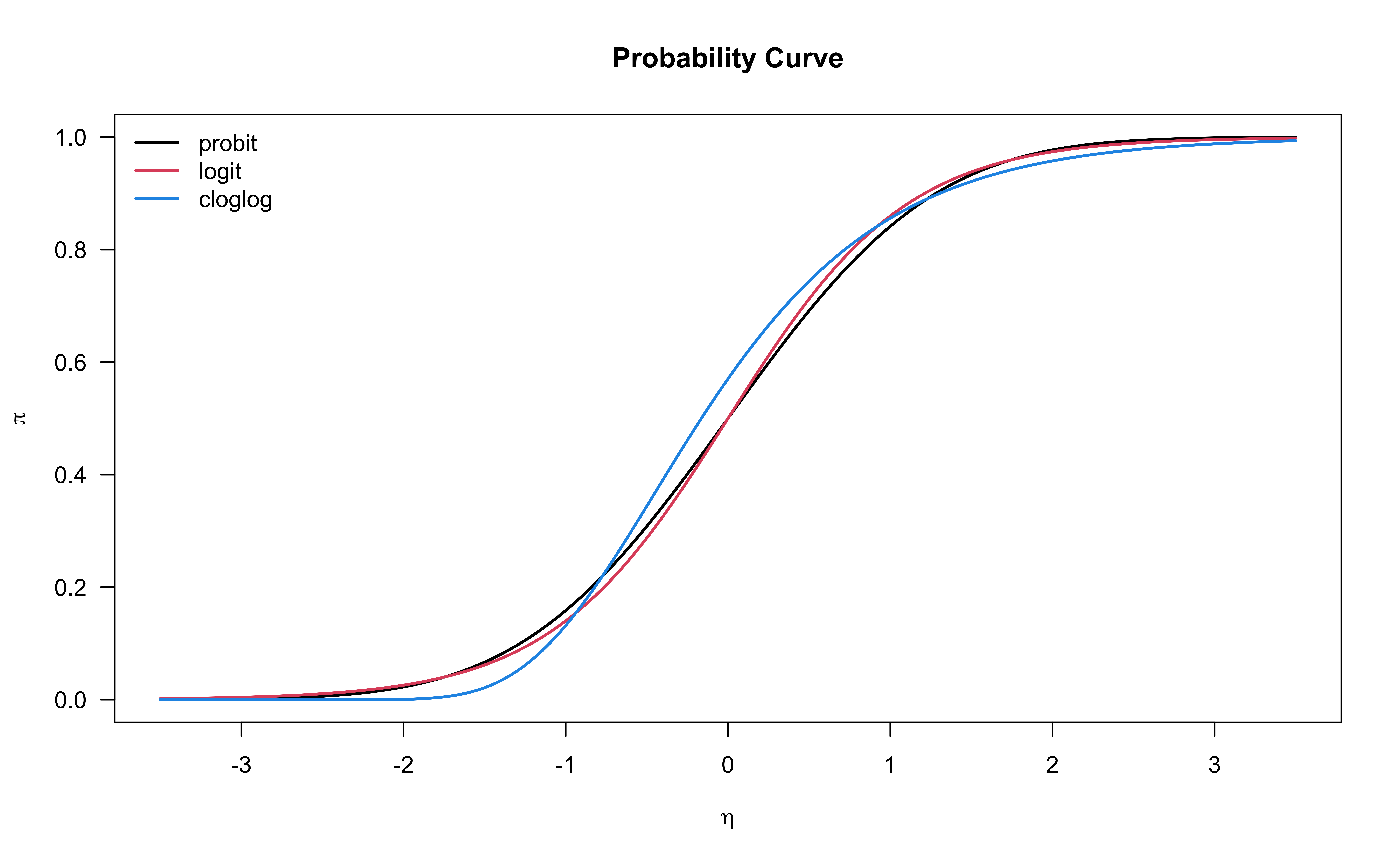
Probit and Complementary log-log Links

Other Topics
Repeated measures and binomial logistic regression
Regression diagnostics for binary data
Penalized logistic regression
Exponential family
Poisson regression